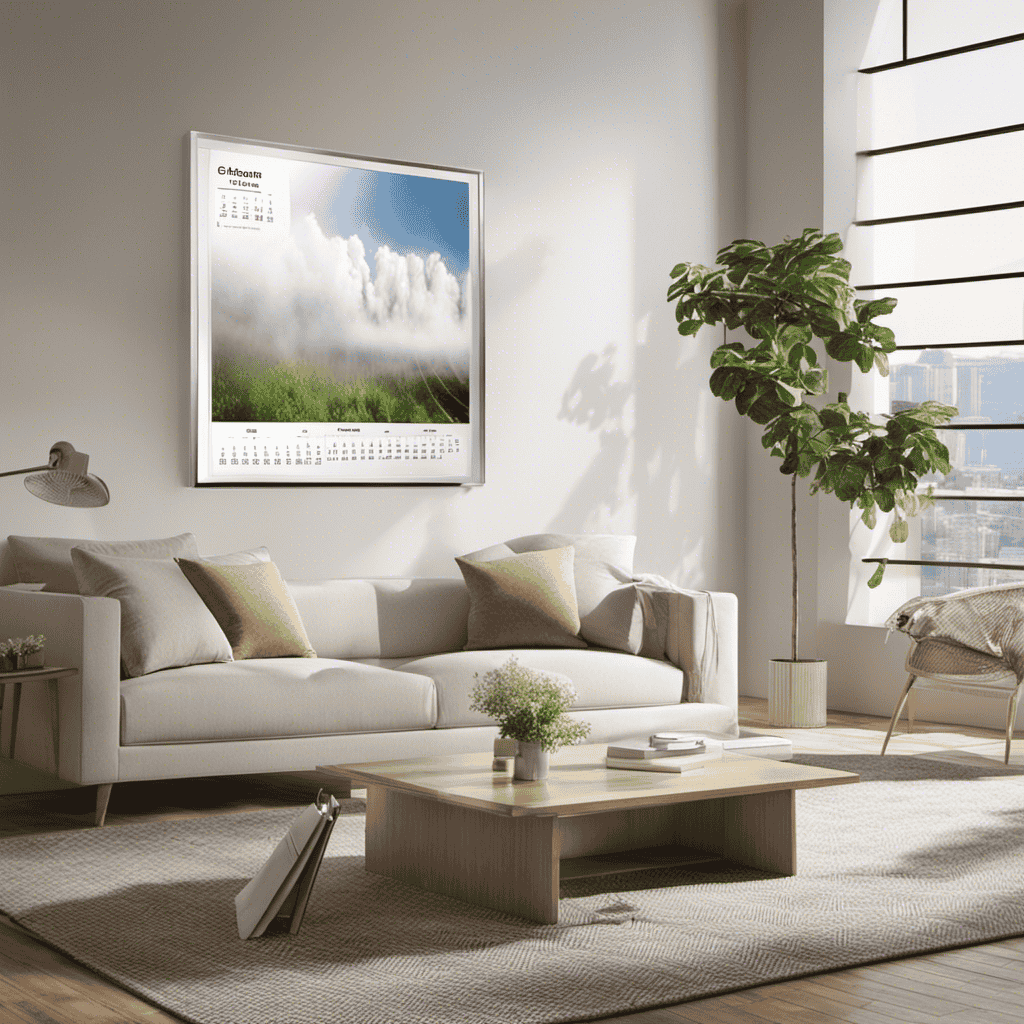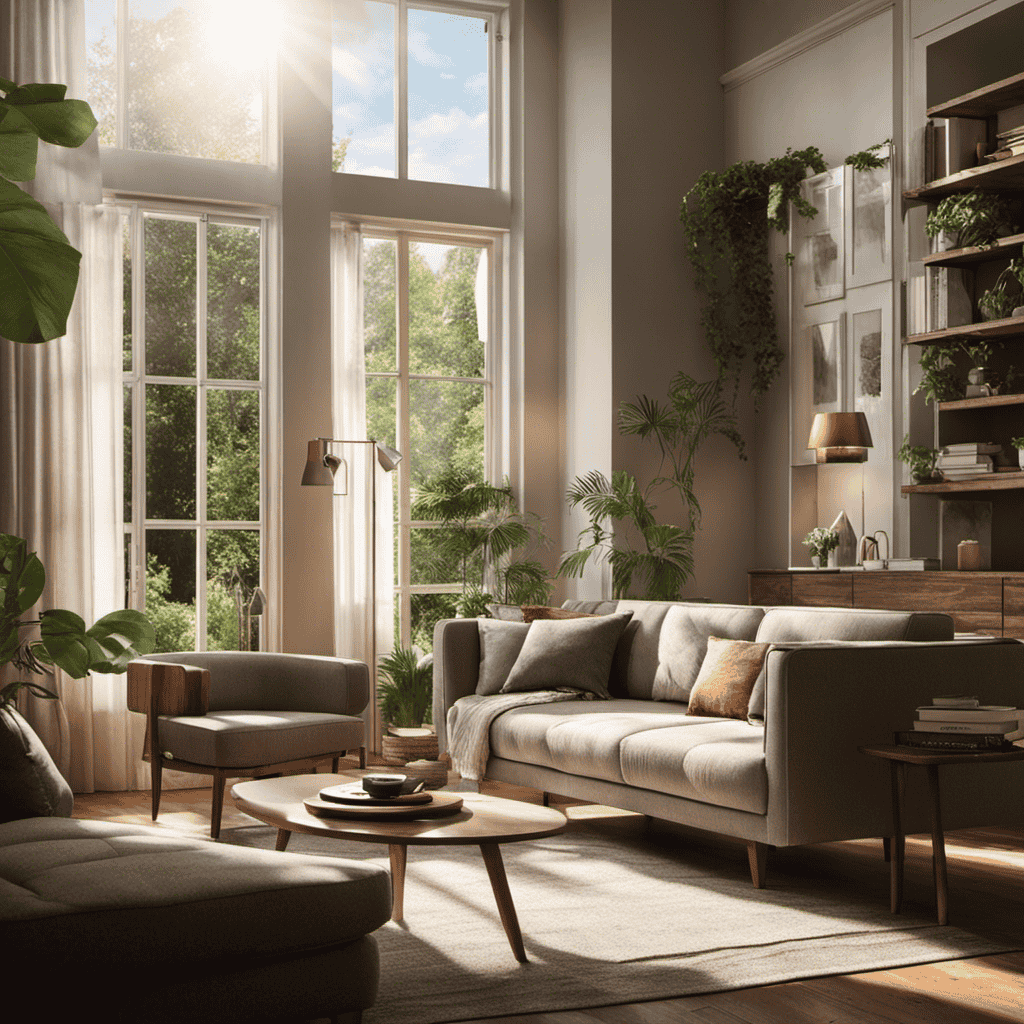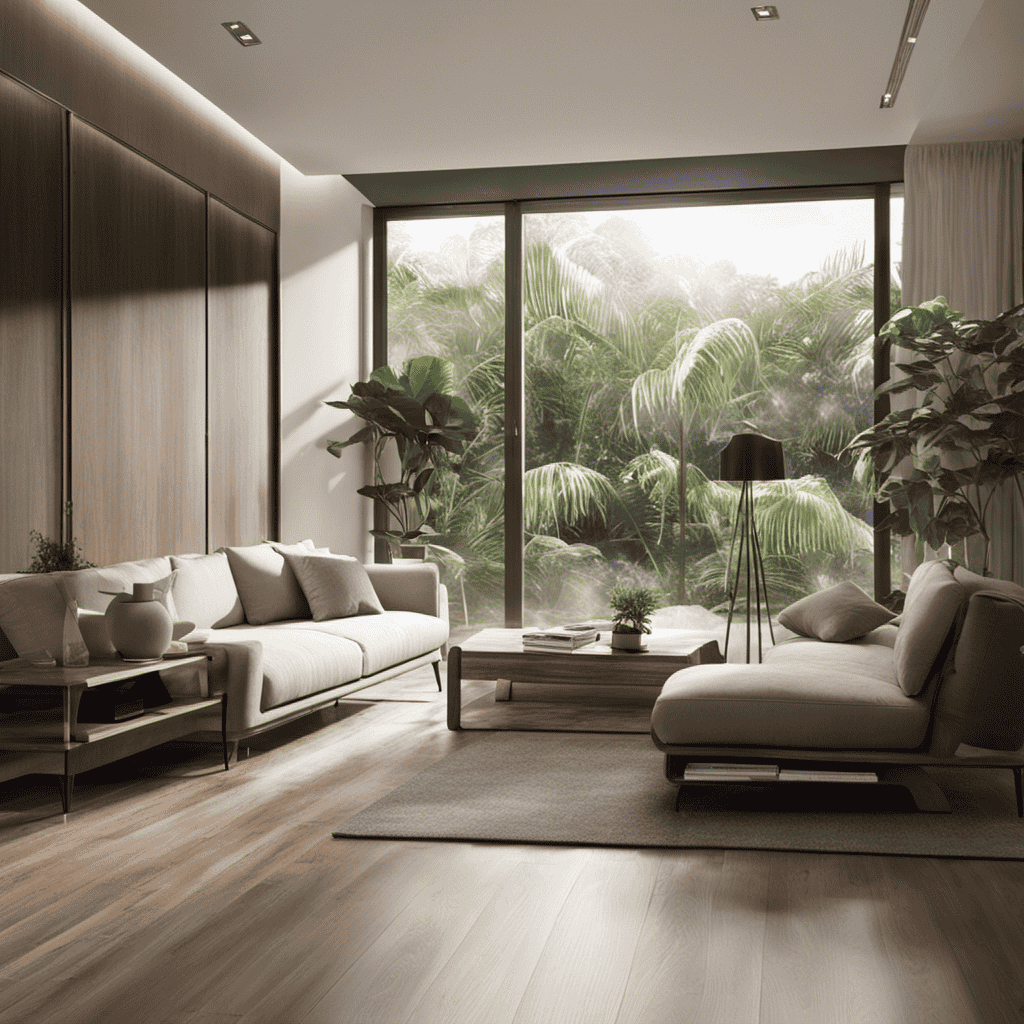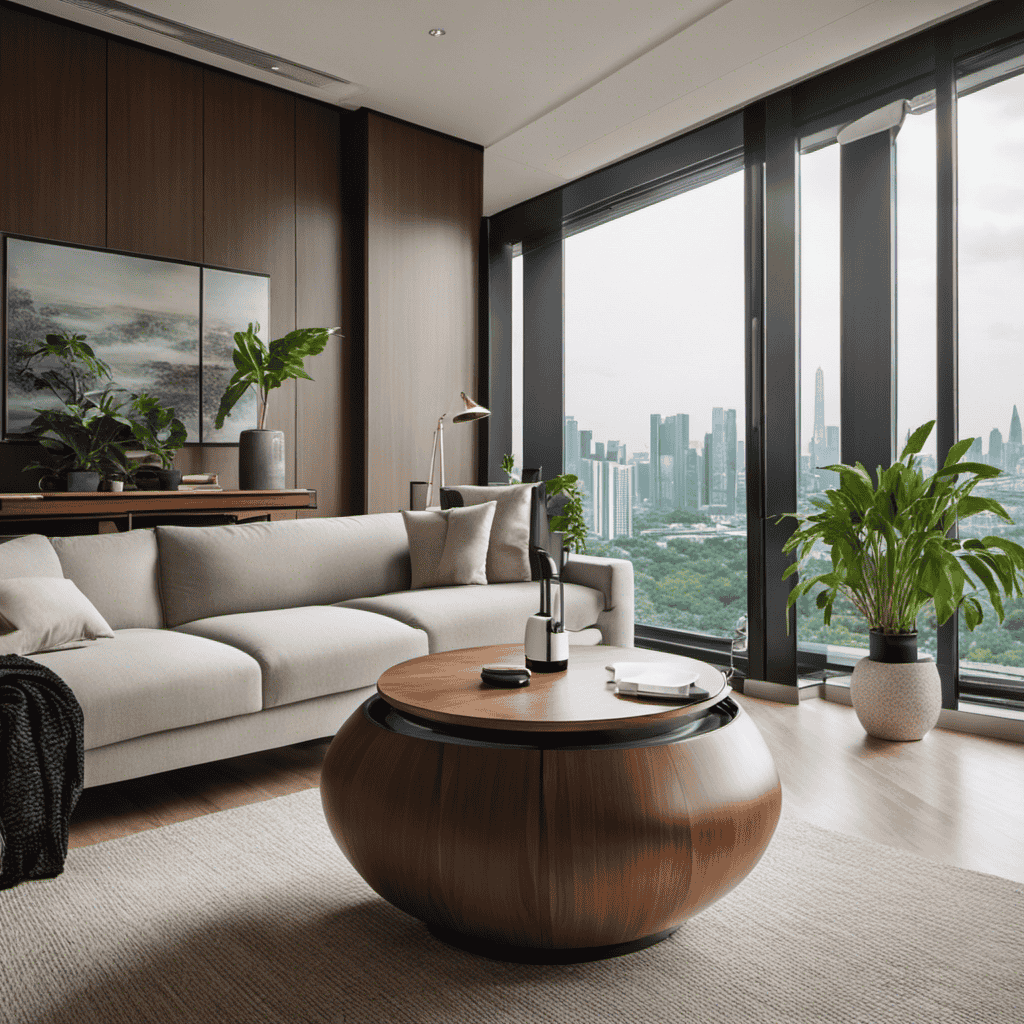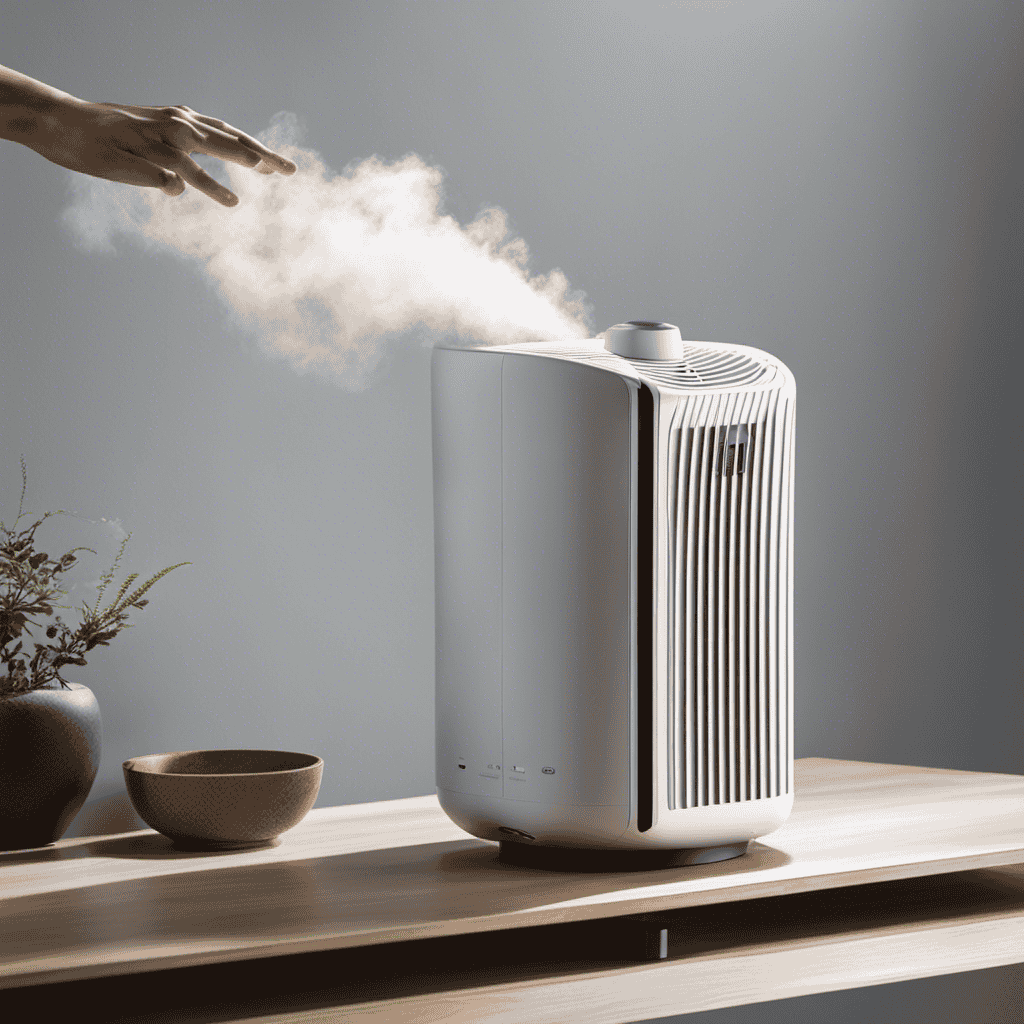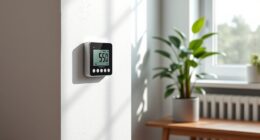Are you aware that the air inside our homes can be up to five times more polluted than the air outside? This is why having an air purifier in your home is essential.
But have you ever wondered how often you should change the air purifier filter? In this article, I will provide you with all the information you need to know about the importance of regular filter changes, factors that determine replacement frequency, and signs that indicate it’s time for a filter change.
Don’t miss out on this essential knowledge for clean and healthy indoor air.
Key Takeaways
- Regularly changing air purifier filters is crucial for maintaining clean and healthy indoor air quality.
- The frequency of filter replacement depends on factors such as pollutant levels, manufacturer recommendations, air pollution levels in the area, occupancy, pets, smokers, cooking activities, allergies, and respiratory conditions.
- Different types of filters have different recommended replacement frequencies, with HEPA filters typically needing replacement every 6 to 12 months, carbon filters lasting around 3 to 6 months, electrostatic filters requiring replacement every few years, and pre-filters needing replacement every 1-3 months.
- Signs that indicate it’s time to change the air purifier filter include visible dirt or dust particles in the air, decreased air quality marked by increased allergies or asthma symptoms, unpleasant odors, and the air purifier’s indicator light signaling filter replacement.
Importance of Regular Air Purifier Filter Changes
Regularly changing your air purifier filter is important for maintaining clean and healthy indoor air quality. When the air filter becomes clogged with dust, pollen, pet dander, and other pollutants, its effectiveness in removing these particles from the air decreases significantly. This can lead to higher pollution levels in your home, which can have negative effects on your health.
By changing the air purifier filter on a regular basis, you can ensure that it continues to trap and remove these pollutants effectively, keeping the air in your home clean and fresh. Clean air benefits include improved respiratory health, reduced allergy symptoms, and a more pleasant living environment.
Factors That Determine Filter Replacement Frequency
When it comes to determining the frequency of air purifier filter replacement, there are two key factors to consider. The first is pollutant levels, which can vary depending on factors such as location, air quality, and personal habits. Higher pollutant levels may require more frequent filter changes. The second factor is the lifespan of the filter itself. Manufacturers often provide recommendations on when to replace filters based on their specific product’s design and capabilities. By taking into account these factors and following the manufacturer’s recommendations, you can help ensure optimal performance and effectiveness of your air purifier.
Pollutant Levels and Lifespan
You’ll want to keep an eye on pollutant levels to determine when it’s time to change your air purifier filter.
Pollutant control is a key aspect of maintaining clean indoor air, and filter efficiency plays a crucial role in this process.
The efficiency of your air purifier filter refers to its ability to trap and remove various pollutants, such as dust, pollen, pet dander, and smoke particles.
As these pollutants accumulate in the filter, it becomes less effective in capturing new contaminants.
Therefore, regularly monitoring the pollutant levels in your environment is essential in determining when to replace the filter.
Manufacturer’s Recommendations
It’s important to follow the manufacturer’s recommendations for maintaining your air purifier. By doing so, you can ensure that your purifier continues to function effectively and efficiently.
Here are some key guidelines to consider:
-
Regular filter maintenance: Keeping your air purifier’s filters clean is crucial for optimal performance. Dust and pollutants can accumulate over time, reducing the purifier’s ability to remove harmful particles from the air.
-
Filter replacement frequency: Different air purifiers have varying recommended filter change frequencies. It is essential to check your manufacturer’s guidelines to determine how often you should replace the filters.
-
Monitoring pollution levels: Pay attention to the pollution levels in your area. If pollution is high, you may need to replace the filters more frequently to maintain air quality.
-
Filter quality: Invest in high-quality filters that are designed to capture a wide range of pollutants effectively.
By following these recommendations, you can ensure that your air purifier operates at its best, providing you with cleaner and healthier indoor air.
Now, let’s delve into the recommended filter change frequency for different air purifier types.
Recommended Filter Change Frequency for Different Air Purifier Types
To ensure optimal air purification, regularly replacing the filter in different types of air purifiers is essential. The frequency at which you should change the filter depends on various factors, including the type of air purifier and the level of pollutant removal needed.
HEPA filters, for example, are highly effective at capturing small particles and should be replaced every 6 to 12 months, depending on the manufacturer’s recommendations. Carbon filters, on the other hand, are designed to remove odors and chemicals and typically have a shorter lifespan of around 3 to 6 months.
Electrostatic filters can be washed and reused, but they should still be replaced every few years to maintain their efficiency. It’s important to follow the specific guidelines provided by the manufacturer to ensure the filter is replaced at the appropriate time and to maintain the air purifier’s effectiveness in removing pollutants.
Signs That Indicate It’s Time to Change Your Air Purifier Filter
When it comes to maintaining optimal air quality in your home, it’s important to pay attention to the filter replacement frequency of your air purifier. Regularly changing the filter ensures that it continues to effectively trap and remove airborne particles.
One of the key indicators that it’s time to replace the filter is the presence of visible dirt or dust particles in the air. This indicates that the filter is no longer able to effectively capture these pollutants.
Additionally, a decrease in air quality can also signal the need for a filter replacement. This can be marked by increased allergies, asthma symptoms, or unpleasant odors.
Filter Replacement Frequency
The recommended frequency for changing an air purifier filter is typically every three to six months. Regular filter replacement is crucial to maintain the effectiveness of your air purifier and ensure clean and healthy air in your home.
Here are the benefits of timely filter changes:
-
Improved Indoor Air Quality: Regularly changing the filter removes allergens, dust, and other pollutants from the air, reducing the risk of respiratory issues and allergies.
-
Enhanced Performance: A clean filter allows your air purifier to work efficiently, effectively capturing and eliminating airborne particles.
-
Extended Lifespan of the Air Purifier: Timely filter changes prevent clogging and damage to the unit, prolonging its lifespan and saving you money in the long run.
-
Peace of Mind: Knowing that your air purifier is working optimally and providing clean air gives you peace of mind and a healthier living environment.
Remember to check your air purifier’s user manual for specific recommendations on the filter replacement schedule.
Visible Dirt or Dust
You may notice visible dirt or dust accumulating on surfaces in your home, indicating that it’s time to replace your air purifier filter. Regular filter maintenance is crucial for ensuring the effectiveness of your air purifier in removing airborne particles and improving indoor air quality.
Over time, the filter becomes clogged with dust, allergens, and other pollutants, reducing its ability to capture contaminants. As a result, more particles may circulate in your home, leading to increased allergies or respiratory issues.
To maintain optimal air purifier effectiveness, it is recommended to check the filter regularly and replace it as needed. Depending on the specific model and usage, filters generally require replacement every 3 to 6 months. However, it is important to consult the manufacturer’s instructions for the recommended filter replacement frequency for your specific air purifier model.
Decreased Air Quality
In my previous subtopic, I discussed how visible dirt or dust can indicate the need to change an air purifier filter.
Now, let’s delve into another important factor that can affect the performance of your air purifier: decreased air quality. When the filter becomes clogged with pollutants, it fails to effectively capture airborne particles, resulting in increased pollutant exposure. This can have detrimental effects on your health, as pollutants such as dust, pollen, pet dander, and mold spores can trigger allergies, asthma attacks, and respiratory issues.
To paint a vivid picture of the consequences of prolonged exposure to poor indoor air quality, consider the following:
- Constant sneezing and itchy eyes
- Difficulty breathing and wheezing
- Frequent headaches and fatigue
- Increased risk of respiratory infections
Understanding the lifespan of air purifier filters is crucial in maintaining healthy indoor air quality, which I will discuss in the subsequent section.
Understanding the Lifespan of Air Purifier Filters
To better understand the lifespan of air purifier filters, it’s important to know how often they need to be changed. The filter lifespan depends on various factors such as the type of filter, the air quality in your environment, and the manufacturer’s recommendations. Generally, most filters need to be replaced every 3 to 6 months, but some may require more frequent changes. It’s crucial to check the filter regularly and follow the manufacturer’s guidelines for maintenance. Neglecting to change the filter can lead to reduced air purification efficiency and potential health risks. Here is a table summarizing the recommended filter lifespan for different types of air purifier filters:
| Filter Type | Lifespan |
|---|---|
| HEPA | 6 months |
| Carbon | 3 months |
| Pre-filter | 3 months |
| Electrostatic | 3 months |
| UV light | 1 year |
How Dirty Filters Affect Air Purifier Efficiency
When filters become dirty, they can significantly impact the efficiency of your air purifier. Dirty filters can hinder the airflow and reduce the purifier’s ability to capture airborne particles effectively. Here are some key points to consider about the impact of dirty filters on air purifier performance:
- Reduced air circulation: A clogged filter restricts the flow of air, making the purifier work harder to pull in and purify the air.
- Decreased filtration efficiency: Dirty filters can become less effective in trapping dust, pollen, and other pollutants, allowing them to circulate back into the room.
- Increased energy consumption: A struggling air purifier consumes more energy to compensate for the reduced airflow, leading to higher electricity bills.
- Potential health risks: When filters are dirty, they may fail to remove allergens and irritants from the air, contributing to respiratory issues and allergies.
Regularly changing and maintaining clean air filters not only improves the performance of your air purifier but also ensures the benefits of clean air filters, such as better air quality and a healthier living environment.
The Impact of Delayed Filter Changes on Indoor Air Quality
In this discussion, I want to address the impact of delayed filter changes on indoor air quality.
Poor air quality can pose significant health risks, especially for those with respiratory conditions.
The efficiency of air purifiers heavily relies on the quality and maintenance of the filters, making regular filter changes essential for optimal performance.
Poor Air, Health Risks
You should be aware that poor air quality can pose health risks. Breathing in polluted air can have a detrimental effect on our respiratory system and overall well-being. Here are some key points to consider:
- Polluted air contains harmful pollutants such as particulate matter, ozone, and volatile organic compounds (VOCs).
- Prolonged exposure to poor air quality can lead to respiratory problems such as asthma, bronchitis, and allergies.
- Children, the elderly, and individuals with pre-existing respiratory conditions are particularly vulnerable to the health effects of poor air quality.
- Indoor air quality can be just as harmful as outdoor air quality, especially in spaces with inadequate ventilation or high levels of indoor pollutants.
It is crucial to take steps to improve and maintain good air quality to safeguard our health and well-being.
Filter Efficiency, Maintenance
To ensure the efficiency and longevity of your air purifier, regularly cleaning and replacing the filter is essential. The filter lifespan can vary depending on factors such as the quality of the air in your environment and the type of filter used. However, a general guideline is to replace the filter every 3 to 6 months. Cleaning the filter monthly can help extend its lifespan. Here are some filter maintenance techniques to consider:
| Technique | Description | Frequency |
|---|---|---|
| Vacuuming | Use a vacuum cleaner with a brush attachment to remove dust and debris from the filter surface. | Monthly |
| Washing | Some filters are washable. Follow the manufacturer’s instructions to safely clean the filter. | Every 3 months |
| Replacement | When the filter becomes visibly dirty or clogged, it’s time to replace it with a new one. | Every 3 to 6 months |
Common Mistakes to Avoid When Changing Air Purifier Filters
Make sure not to overlook these common mistakes when changing your air purifier filters. It’s important to handle this process with care to ensure proper disposal and maintain the efficiency of your air purifier. Here are a few key mistakes to avoid:
-
Neglecting to read the manufacturer’s instructions: Each air purifier model may have specific filter replacement instructions that you should follow to avoid damaging the unit.
-
Forgetting to turn off the power: Always remember to turn off the power before removing or replacing the filters to prevent any electrical accidents.
-
Failing to clean the unit before replacing the filters: Dust and debris can accumulate inside the air purifier, so it’s crucial to clean the unit before installing the new filters.
-
Not properly disposing of the old filters: Since air purifier filters can contain pollutants and allergens, it’s important to dispose of them properly to prevent any contamination.
By avoiding these common mistakes, you can ensure the longevity and effectiveness of your air purifier.
Now, let’s explore how to extend the lifespan of your air purifier filter.
How to Extend the Lifespan of Your Air Purifier Filter
Now that we’ve discussed the common mistakes to avoid when changing air purifier filters, let’s talk about how to extend the lifespan of your air purifier filter. By following a few simple maintenance tips, you can ensure that your filter lasts longer and performs at its best.
First, regularly check and clean your air purifier’s pre-filter. This pre-filter captures larger particles and helps prevent them from clogging the main filter. Clean it according to the manufacturer’s instructions or replace it when necessary.
Next, vacuum or wipe down the exterior of your air purifier to remove any dust or debris that may have accumulated. This will prevent it from being pulled into the filter and reducing its effectiveness.
Finally, avoid placing your air purifier near sources of smoke or strong odors, as these can quickly saturate the filter and require more frequent replacements.
By implementing these filter maintenance tips, you can maximize the lifespan of your air purifier filter and ensure its optimal performance.
Now, let’s move on to discussing the different filter replacement options for air purifiers.
Different Filter Replacement Options for Air Purifiers
If you’re looking for alternatives, there are different filter replacement options available for air purifiers. It’s important to consider the different filter brands and their filter replacement frequency comparison. Here are some options to consider:
-
HEPA Filters: These filters are highly effective in removing small particles from the air, such as dust, pollen, and pet dander. They typically need to be replaced every 6 to 12 months, depending on the usage and air quality.
-
Activated Carbon Filters: These filters are great for removing odors, gases, and chemicals from the air. They usually last around 6 months before needing to be replaced.
-
Pre-Filters: These filters capture larger particles, extending the lifespan of the main filter. They should be replaced every 3 to 6 months, depending on the amount of dust and debris in the air.
-
Washable Filters: Some air purifiers come with washable filters, which can be reused after cleaning. These filters are cost-effective and environmentally friendly.
The Role of Filter Maintenance in Prolonging Air Purifier Lifespan
To prolong the lifespan of your air purifier, regularly cleaning and replacing the filters is essential. By maintaining the filters, you ensure that your air purifier continues to perform at its best and effectively removes airborne pollutants from your indoor environment. Here are some filter maintenance tips to help you keep your air purifier in top condition:
- Clean or replace pre-filters every 1-3 months, depending on usage and air quality.
- Replace HEPA filters every 6-12 months, or as recommended by the manufacturer.
- Clean or replace carbon filters every 3-6 months, or as needed.
Regular filter maintenance offers several benefits, such as:
- Improved air quality: Clean filters remove dust, allergens, and other pollutants, providing you with cleaner and healthier indoor air.
- Enhanced performance: Clean filters allow air purifiers to work efficiently, ensuring maximum air purification.
- Extended lifespan: Proper filter maintenance helps prolong the lifespan of your air purifier, saving you money in the long run.
How to Properly Dispose of Used Air Purifier Filters
When disposing of used filters, make sure to follow proper guidelines to ensure safe and environmentally-friendly disposal. Improper disposal of air purifier filters can have detrimental effects on the environment and human health.
Here are some important points to consider for proper disposal:
-
Recycling options: Many air purifier filters can be recycled, reducing waste and conserving resources. Check with your local recycling center or waste management facility to see if they accept used filters for recycling.
-
Hazardous materials: Some air purifier filters may contain hazardous materials such as mercury or lead. It is crucial to handle and dispose of these filters properly to prevent contamination.
-
Manufacturer recommendations: Always refer to the manufacturer’s instructions for proper disposal. They may provide specific guidelines or recycling programs for their filters.
-
Alternative disposal methods: If recycling is not available, contact your local authorities for guidance on the proper disposal of used filters.
The Cost Considerations of Regular Filter Changes
When it comes to air purifiers, it’s important to consider the financial impact of regular filter changes. These filters play a crucial role in maintaining clean and healthy indoor air quality, but they also come with a cost.
Therefore, conducting a long-term cost analysis can help determine the overall expense of using air purifiers and the frequency at which filters need to be replaced.
Financial Impact of Filters
You should consider the financial impact of regularly changing air purifier filters. Not only does it improve the air quality in your home, but it also saves you money in the long run.
Here are some key points to keep in mind when it comes to the cost savings and budget planning associated with filter changes:
-
Extended filter lifespan: By regularly changing your air purifier filters, you can maximize their lifespan, reducing the frequency of replacements and saving money on purchasing new filters.
-
Energy efficiency: Clean filters allow your air purifier to work more efficiently, reducing energy consumption and lowering your electricity bills.
-
Improved health: Regular filter changes ensure that your air purifier is effectively removing allergens and pollutants from the air, leading to improved health and potential cost savings on medical expenses.
-
Long-term investment: While there may be upfront costs associated with purchasing new filters, the long-term benefits of improved air quality and cost savings outweigh the initial investment.
Considering the financial impact of filter changes is crucial for effective budget planning and maintaining a healthy home environment.
Long-Term Cost Analysis
Regularly replacing air purifier filters can lead to long-term cost savings and improved air quality in your home. By implementing cost-saving methods and optimizing the filter lifespan, you can reduce expenses and ensure efficient air purification.
One cost-saving method is to choose high-quality filters that have a longer lifespan. These filters may have a higher upfront cost, but they can last longer and save you money in the long run. Additionally, it is important to clean and maintain the filters regularly to prolong their effectiveness. This includes vacuuming or washing them, as well as following the manufacturer’s instructions for filter replacement.
By adopting these practices, you can maximize the lifespan of your air purifier filters and minimize the need for frequent replacements.
Transitioning into the next section, let’s explore expert recommendations for air purifier filter replacement.
Expert Recommendations for Air Purifier Filter Replacement
Experts typically recommend replacing your air purifier filter every six to twelve months. This ensures optimal performance and clean air in your home. Here are some key expert filter replacement advice to consider:
- Regular filter changes improve air quality and reduce allergens, promoting a healthier living environment.
- Neglecting filter replacement can lead to reduced efficiency, increased energy consumption, and potential damage to your air purifier.
- Changing filters regularly helps prolong the lifespan of your air purifier, saving you money in the long run.
- Following expert advice on filter replacement ensures that you are getting the most out of your air purifier and maximizing its effectiveness.
By adhering to these guidelines, you can maintain a clean and healthy indoor environment.
Now, let’s explore troubleshooting common issues related to air purifier filters.
Troubleshooting Common Issues Related to Air Purifier Filters
If you’re experiencing issues with your air purifier, troubleshooting common problems related to the filter can help resolve them. Here are some troubleshooting solutions for common filter problems:
| Problem | Solution |
|---|---|
| Air purifier not turning on | Check if the filter is properly installed and securely in place. |
| Weak airflow | Clean or replace the filter if it is dirty or clogged. |
| Strange odors | Replace the filter and clean the unit to remove any buildup. |
| Filter indicator light not working | Reset the filter indicator or replace the batteries. |
| Filter not lasting long enough | Ensure you are using the correct filter and follow the manufacturer’s recommendations for filter replacement intervals. |
What Are the Benefits of Regularly Changing an Air Purifier Filter?
Regular air purifier filter change frequency is crucial for maintaining clean indoor air. By regularly changing the filter, you can ensure that the air purifier is effectively removing pollutants and allergens from the air. This can lead to better respiratory health and overall well-being for you and your family.
Frequently Asked Questions
Can I Clean My Air Purifier Filter Instead of Replacing It?
Cleaning an air purifier filter instead of replacing it has pros and cons. The benefits include cost savings and reduced waste. However, it may not effectively remove all pollutants and can pose health risks if not cleaned properly.
How Can I Determine if My Air Purifier Filter Needs to Be Changed?
Determining when to change your air purifier filter is crucial for clean air. Signs of a dirty filter include reduced airflow and unpleasant odors. Follow the manufacturer’s guidelines on how often to clean or replace the filter.
What Are the Consequences of Not Changing My Air Purifier Filter Regularly?
Neglecting air purifier filter replacement can lead to poor indoor air quality and health issues. Regular maintenance is crucial to ensure optimal performance, preventing the buildup of pollutants and maintaining a clean and healthy environment.
Are There Any DIY Methods for Extending the Lifespan of Air Purifier Filters?
There are effective DIY methods for extending the lifespan of air purifier filters. Regular cleaning, vacuuming, and using pre-filters can help remove particles and debris, reducing the need for frequent filter changes.
Can I Use a Different Brand of Filter With My Air Purifier?
I can use a different brand of filter with my air purifier, but I need to consider compatibility concerns. It’s important to ensure that the alternative filter options are compatible with my specific air purifier model.
Is the Frequency of Changing Filter Different for Different Air Purifier Brands?
When it comes to the dyson air purifier filter change frequency, different air purifier brands vary in their recommended schedules. Some may require a filter change every 3 months, while others may suggest a longer interval of 6 months. It’s important to follow the specific guidelines for your particular air purifier to ensure optimal performance.
Conclusion
In conclusion, it’s crucial to regularly change the air purifier filter to maintain clean and healthy indoor air. The frequency of filter replacement depends on various factors such as the type of air purifier and the level of pollutants in your environment.
By paying attention to signs like decreased airflow and unpleasant odors, you can determine when it’s time to replace the filter. Properly disposing of used filters and considering the cost implications are also important.
Following expert recommendations and troubleshooting common issues will ensure efficient air purification. Remember, neglecting filter changes can have catastrophic consequences for your air quality!

